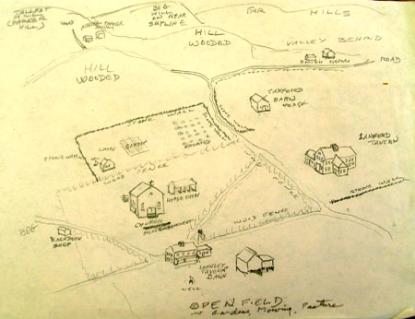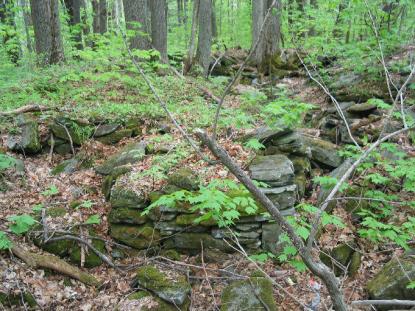But gradually, as people thought more of manufactures and less of husbandry, locations along the streams became important, and the settlements away from them, and often quite above them, were gradually abandoned.This transition had already been going on for some time in Olney [Hawley]; and the progress of it, has since been such that our stores, our taverns, our post-office, and our shops are all gone, and we do not think another building will ever be put up in what was once the center of that town.–Reverend Rufus Taylor, Cottage Piety Exemplified (1869)
Ray Gotta, one of my colleagues on the Hawley Historical Commission, lives directly across the road from Hawley’s old town common. From 1794 to 1848 the common served as the religious, civic, social, and economic center of the town. A meetinghouse occupied the middle of it and two taverns, a blacksmith shop, and several houses stood close by, including the homes of Hawley’s first ministers and doctors. One of the taverns housed Hawley’s first post office. A third tavern existed for a brief time between 1798 and 1804. The townspeople gathered for religious services and town meetings in the meetinghouse, socialized at the taverns with each other and with people passing through or doing business in the town, and sometimes appeared for legal proceedings before one of the tavern keepers, who functioned as a magistrate.
If it weren’t for the brass plaque on a large stone that marks the site of the first meetinghouse in Hawley, you wouldn’t know a village had ever been there. The town still owns most of the common, which was originally about two acres in size, but until recently most residents remained unaware that it ever existed. In 1891, it was “a pretty sightly place,” with dramatic views toward the north. Now mature trees block those views and obscure the remnants of the buildings that once surrounded the common. As in the other hilltowns of Western Massachusetts, you have to read the landscape of cellar holes, stone walls, and abandoned roads buried in the woods to apprehend the history of the area.
Ray and Phyllis Gotta’s cottage sits on the central foundation of the Longley Tavern that once served Hawley’s residents and the travelers who came to do business or stop to refresh themselves on their way to somewhere else. Ray learned much of what he knows about Hawley’s town common from the late Harrison Parker, who published an account of its history in 1985 and led a tour of the area that Ray still remembers. But the story of the common remained largely unknown and Ray believed something more permanent should be done to preserve and interpret what had once been the vital center of our community.
When Ray proposed "Rediscovering Hawley’s Old Town Common” to the Historical Commission, Lark Thwing and I eagerly embraced the idea. The three of us also serve on the board of the Sons and Daughters of Hawley, the town’s historical society, and our colleagues on the board agreed that we should seek funding for the project. With the guidance and encouragement of Pleun Bouricius, a program officer at Mass Humanities, we applied for a Scholar-in-Residence Grant. The awarding of the grant last summer allowed me to begin the process of rediscovery.
“Rediscovering Hawley’s Old Town Common,” suited my professional interests perfectly since the history of the American landscape has been a major theme of my work since graduate school. But, like Ray, I also had a personal connection to the place we sought to understand and make known. Rufus Sears, one of my forbearers, settled in Hawley in 1781, worshipped in the meetinghouse on the common, and served the town in various capacities (surveyor of highways, hogreeve, tithingman, constable). Working on this project helped me envision the landscape and community that members of my family and their neighbors inhabited five generations back.
Harrison’s account of the creation and later abandonment of the common and what you might call his genealogy of the properties surrounding it—who owned them, the structures built on them, when and why they changed hands—provided a strong foundation for my investigations.

Drawing of Hawley Town Common (by Harrison Parker, ca. 1980s?)as it may have looked circa 1820-30. Harrison Parker Papers. Special Collections, W.E.B. Du Bois Library, University of Massachusetts Amherst.
My goal was to put those details in a larger context. What are New England “town commons”? How did they come into being? What did they look like? What purposes did they serve? How is Hawley’s town common alike or different from other Massachusetts town commons? What political, religious, and economic forces shaped and reshaped Massachusetts town commons between 1794 and 1848? Why did Hawley’s disappear?
For most of us, local history is the history we live: our daily economic life, our relationships with our family and neighbors, our involvement in organizations and religious congregations to which we belong, our participation in the government of our community (even if this means just paying our property taxes). But this history is not just local; it reflects the forms of economic and social organization that shaped the communities in which we live and it responds to the larger forces that gradually, or sometimes suddenly (as we have seen recently), alter the economic and social landscape. “Local history implies the history of larger communities,” Lewis Mumford once said. “Every great event sweeps over the country like a wave; but it leaves its deposit behind in the life of the locality.”
The concept of common land goes back to medieval England and was altered by the abundance of land and other circumstances in America. Hawley followed a pattern of town settlement that changed as it moved westward from the earliest New England settlements. Hawley’s topography—its steep hills and narrow valleys running north and south—posed special challenges that influenced the fate of its town common. A religious revival and the growing strength of the temperance movement brought an end to the consumption of liquor in the taverns at Hawley’s town common and, presumably, a shrinking of their income. The eleventh amendment to the Massachusetts constitution separated church and state and compelled the town of Hawley to construct a separate town house for conducting town business. A rerouting of the stagecoach route from Boston to Albany through South Hawley drew commerce away from the common.
The disappearance of the village that once flourished around Hawley’s town common is, in fact, an archetypal American story. From the founding of the country, the vanishing of a town center, or even a whole town, has been a significant part of the history of American settlement. Settlement and de-settlement. The railroad arrives. Built through one town it leads to prosperity, but the town ten miles south, bypassed by the railroad, withers and dies. The local often tells a larger story.

Ruins of the Sanford Tavern at the site of Hawley's old town common
The goal of “Rediscovering Hawley’s Old Town Common” is to create an educational historic site with paths leading the visitor to the cellar holes and other evidence of the vanished community. Signage will orient visitors, invite them to “read” the landscape, and help them discover both the particular history of Hawley’s town common and its greater meaning.
The Highland Communities Initiative recently awarded the Sons & Daughters of Hawley a grant to work with Sustainable Design Associates, a Northampton landscape design firm, to develop a site plan. A second grant received from Mass Humanities—together with an abundance of volunteer labor supplied by Hawley’s sons and daughters—will implement the project. Dedication of the site will take place on Hawley Day, August 2010. You are invited to be there!


